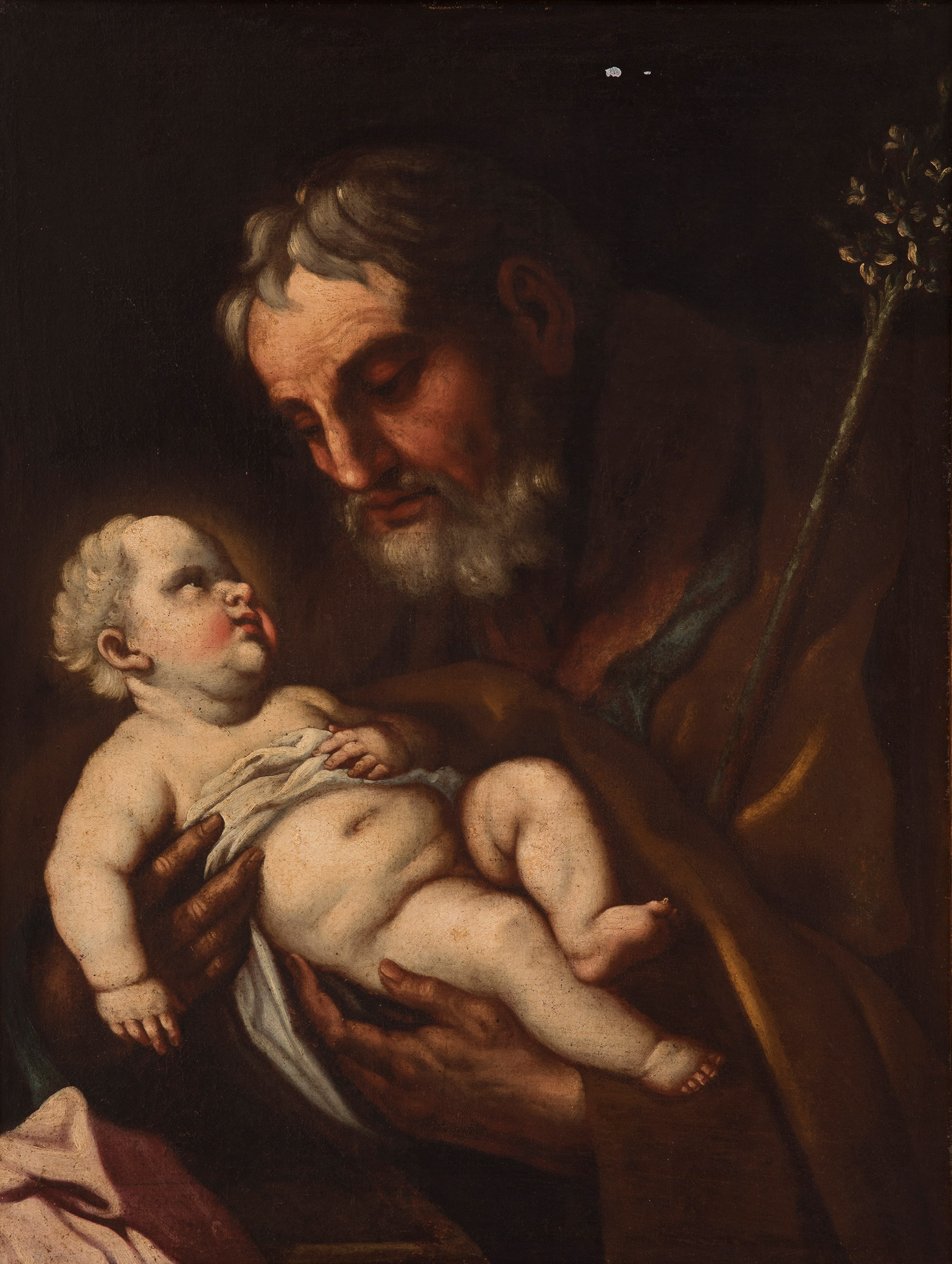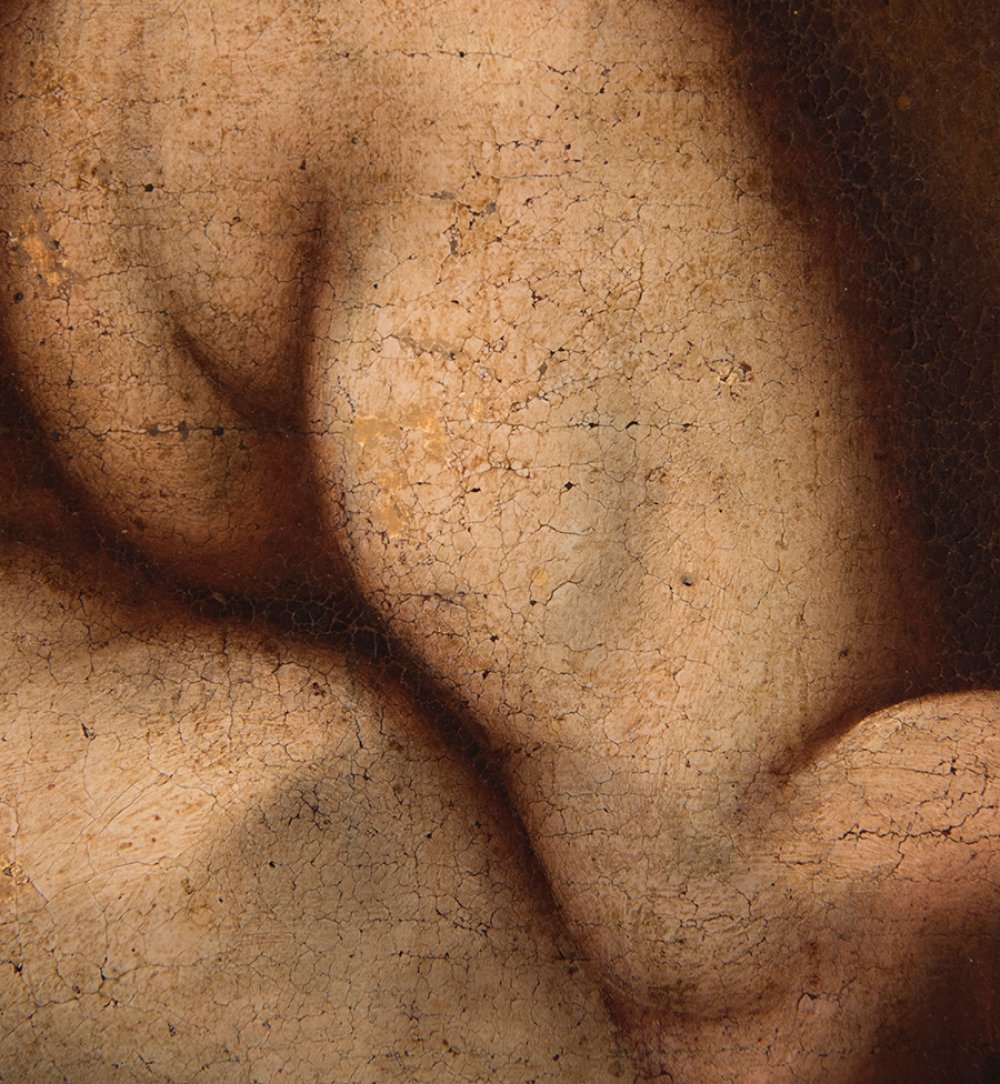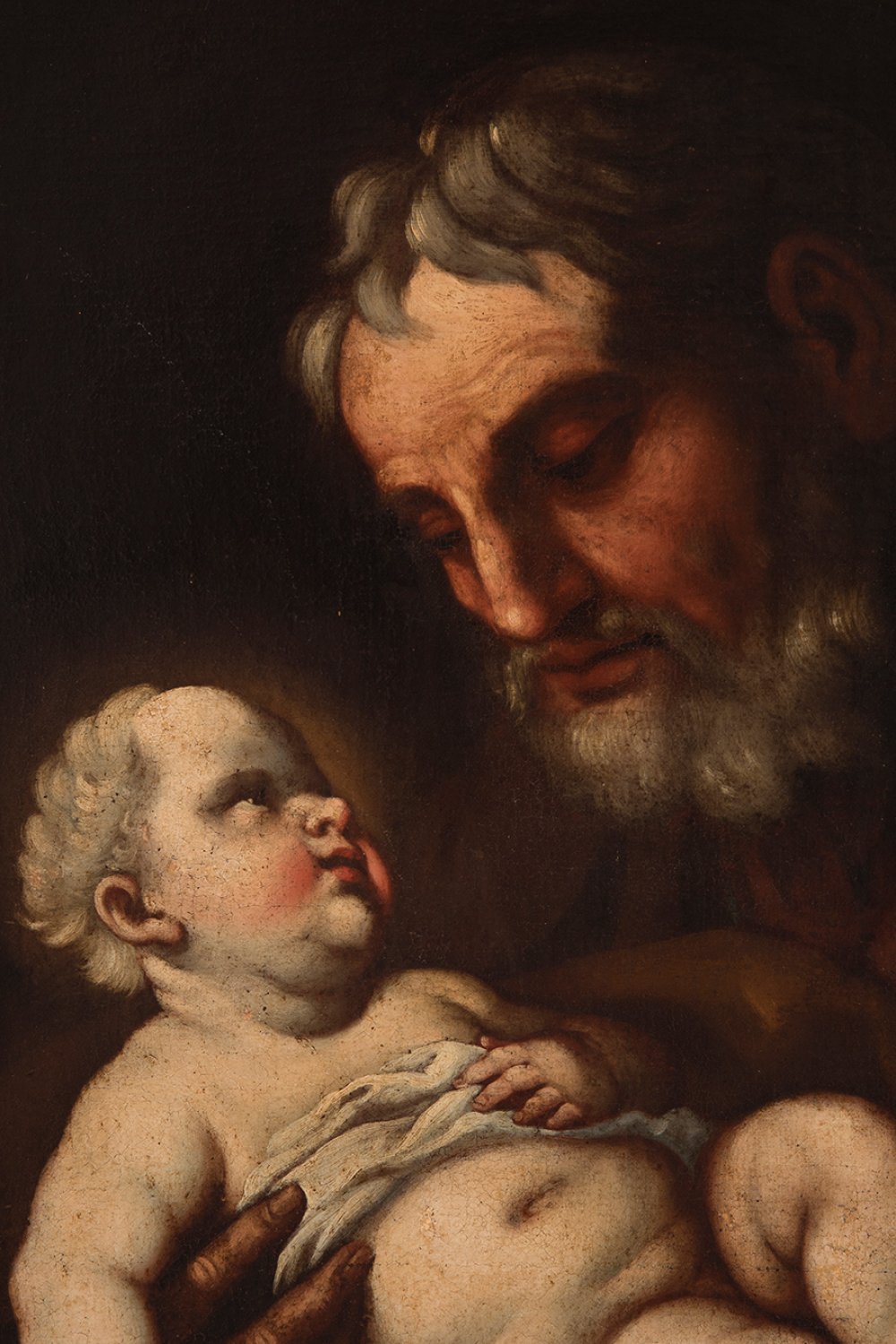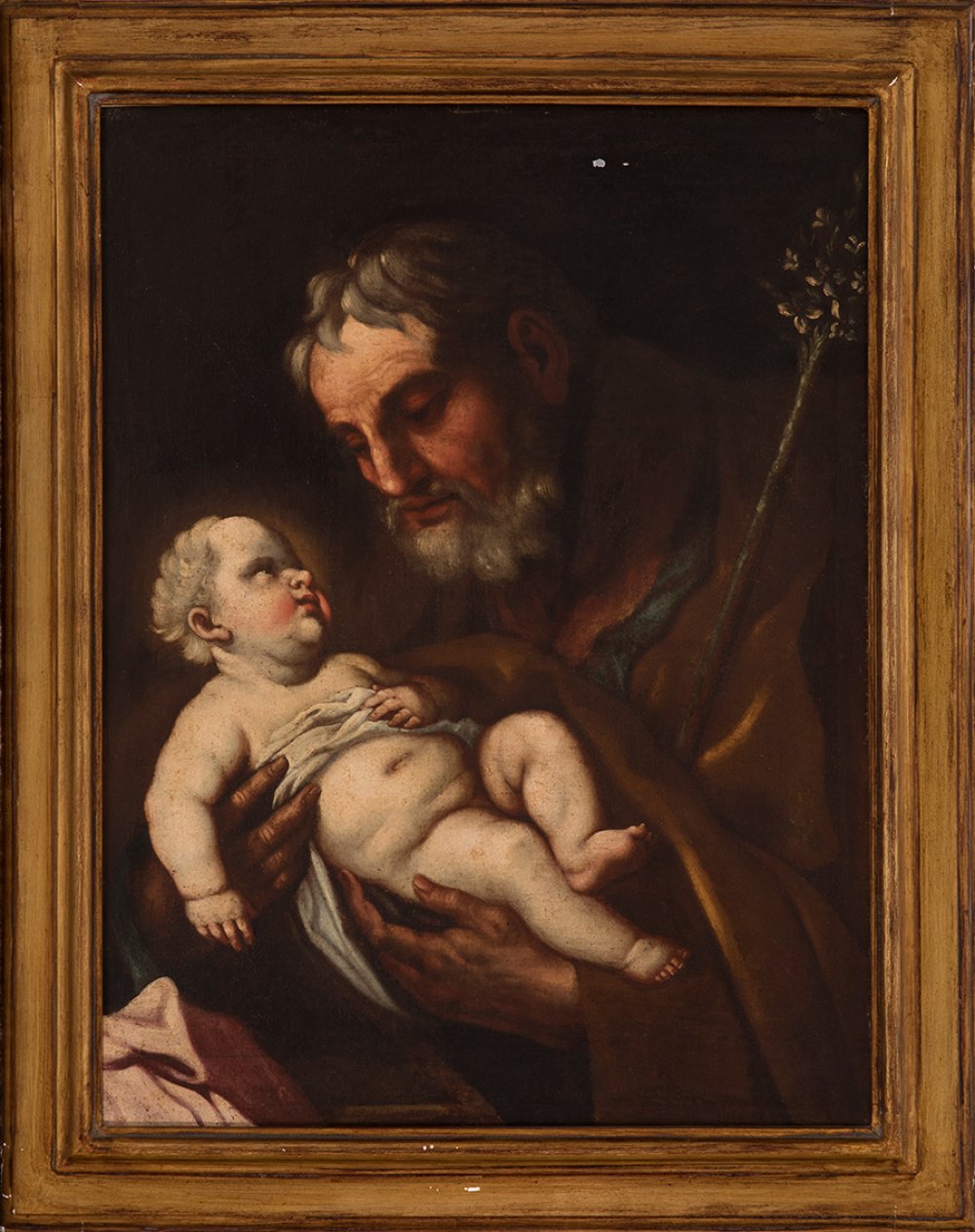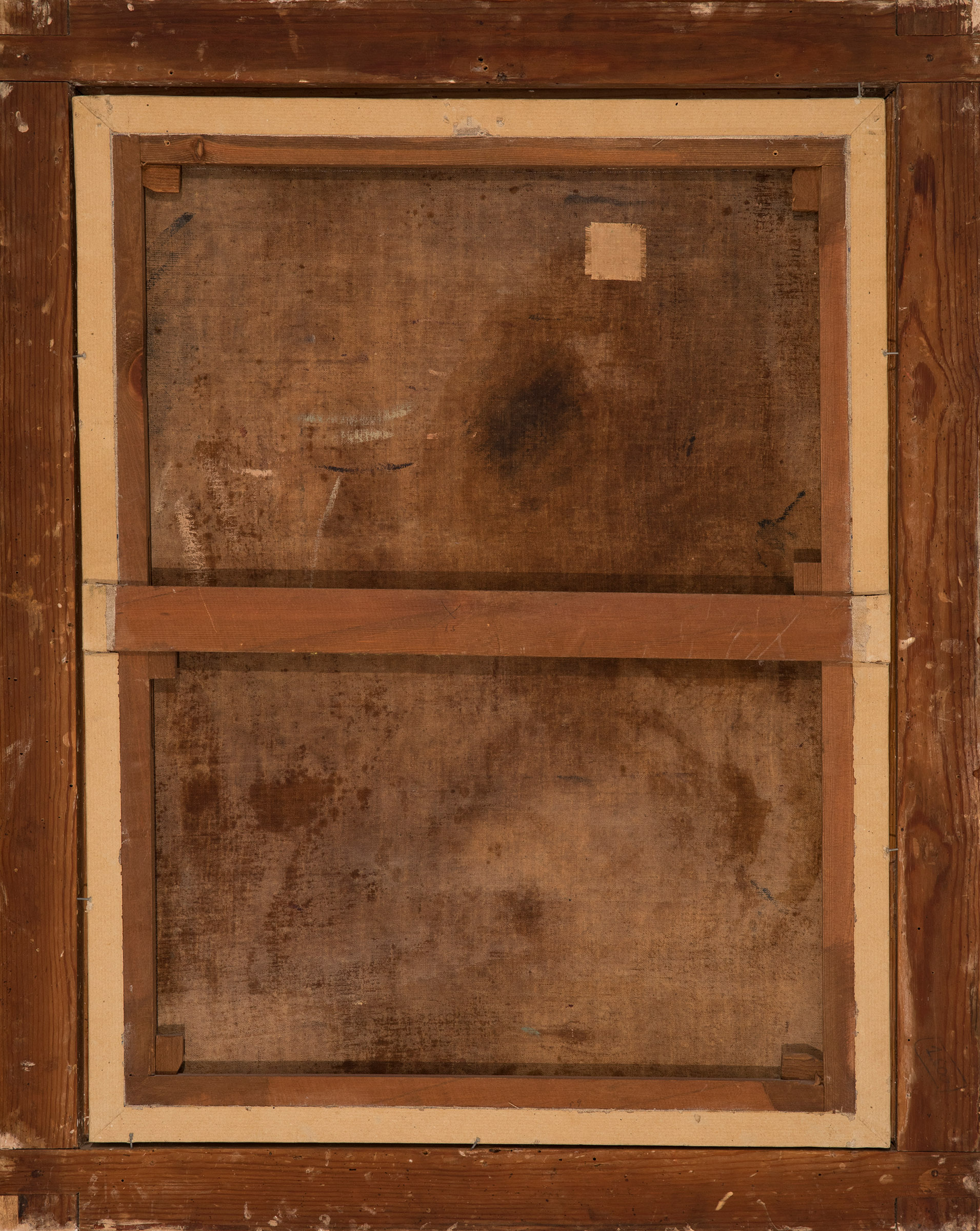34
School of LUCA GIORDANO (Naples, 1634 - 1705)."Saint Joseph with Child".Oil on canvas.The original
"Saint Joseph with Child".
Oil on canvas.
The original canvas is preserved.
It has repainting and restorations on the pictorial layer.
It has redorado in the frame.
Measurements: 77 x 59 cm: 91 x 72,5 cm (frame).
The work shows Saint Joseph, identified by the flowered rod, seated with the Child in his lap, in a family scene full of tenderness typical of the Sevillian master. Until the Counter-Reformation, the figure of Saint Joseph was usually relegated to the background as he was not accorded any theological importance. After Trent, however, his leading role as Jesus' protector during his childhood and as a guide during his youth was revived, and he is depicted here as such. In contrast to the tenderness, defencelessness and candour of the infant figure, Saint Joseph is presented as a monumental, typically Baroque figure, an impression that is reinforced by the pyramidal composition. Through this form of representation, the author visually emphasises the decisive role of Jesus' putative father as protector.
Due to the technical characteristics, such as the directed light, the sobriety of the colour palette and the composition of the scene, it is possible to place this scene in the Italian Baroque period, particularly in relation to the artistic circle of Luca Giordano (Naples, 1634-1705), who painted scenes very similar to the present one. Giordano enjoyed great popularity during his lifetime, both in Italy and Spain. His style was influenced by artists such as Mattia Preti, Rubens, Bernini and, above all, Pietro da Cortona, whose physical types inspired those of Giordano. During the late 1670s he began his large-scale mural decorations (Montecassino, 1677-1678, and San Gregorio Armeno, Naples, 1679), followed in 1682 by the dome of the Corsini chapel in the church of Carmine (Florence) and those of the gallery and library of the Palazzo Medici Ricardi (Florence). In 1692 he was called to Madrid to carry out the mural decorations in the monastery of El Escorial, both in the staircase and in the vaults of the basilica, where he worked from 1692 to 1694. The former is his most painstaking work, the process of which was closely followed by the monarch himself, Charles II. This was followed by the decoration of the monarch's office and bedroom (destroyed) in the Royal Palace of Aranjuez. He was then commissioned to decorate the Casón del Buen Retiro (ca. 1697); the sacristy of Toledo Cathedral (1698); the decoration of the royal chapel of the Alcázar (destroyed); and Saint Anthony of the Portuguese (1699), in which Giordano depicted eight scenes from the life of Saint Anthony of Padua painted on tapestries. The arrival of Philip V in 1701 and the outbreak of the War of the Spanish Succession led to the end of his royal commissions and his return to Naples, although he continued to send paintings to Spain.
"Saint Joseph with Child".
Oil on canvas.
The original canvas is preserved.
It has repainting and restorations on the pictorial layer.
It has redorado in the frame.
Measurements: 77 x 59 cm: 91 x 72,5 cm (frame).
The work shows Saint Joseph, identified by the flowered rod, seated with the Child in his lap, in a family scene full of tenderness typical of the Sevillian master. Until the Counter-Reformation, the figure of Saint Joseph was usually relegated to the background as he was not accorded any theological importance. After Trent, however, his leading role as Jesus' protector during his childhood and as a guide during his youth was revived, and he is depicted here as such. In contrast to the tenderness, defencelessness and candour of the infant figure, Saint Joseph is presented as a monumental, typically Baroque figure, an impression that is reinforced by the pyramidal composition. Through this form of representation, the author visually emphasises the decisive role of Jesus' putative father as protector.
Due to the technical characteristics, such as the directed light, the sobriety of the colour palette and the composition of the scene, it is possible to place this scene in the Italian Baroque period, particularly in relation to the artistic circle of Luca Giordano (Naples, 1634-1705), who painted scenes very similar to the present one. Giordano enjoyed great popularity during his lifetime, both in Italy and Spain. His style was influenced by artists such as Mattia Preti, Rubens, Bernini and, above all, Pietro da Cortona, whose physical types inspired those of Giordano. During the late 1670s he began his large-scale mural decorations (Montecassino, 1677-1678, and San Gregorio Armeno, Naples, 1679), followed in 1682 by the dome of the Corsini chapel in the church of Carmine (Florence) and those of the gallery and library of the Palazzo Medici Ricardi (Florence). In 1692 he was called to Madrid to carry out the mural decorations in the monastery of El Escorial, both in the staircase and in the vaults of the basilica, where he worked from 1692 to 1694. The former is his most painstaking work, the process of which was closely followed by the monarch himself, Charles II. This was followed by the decoration of the monarch's office and bedroom (destroyed) in the Royal Palace of Aranjuez. He was then commissioned to decorate the Casón del Buen Retiro (ca. 1697); the sacristy of Toledo Cathedral (1698); the decoration of the royal chapel of the Alcázar (destroyed); and Saint Anthony of the Portuguese (1699), in which Giordano depicted eight scenes from the life of Saint Anthony of Padua painted on tapestries. The arrival of Philip V in 1701 and the outbreak of the War of the Spanish Succession led to the end of his royal commissions and his return to Naples, although he continued to send paintings to Spain.
7th September - Old Masters
Sale Date(s)
Venue Address
General delivery information available from the auctioneer
Setdart offers Worldwide shipping
PICK UP IN ROOM: You can come and pick up your lots in our offices (Barcelona, Madrid or Valencia). At the moment of the withdrawal, you will be able to accept the current conditions of the lot by means of a document that you will sign.
YOU CAN SEND ANOTHER PERSON TO PICK UP: This person must present a signed authorization that you can find in our web page by accessing from BUY AT SETDART- LOGISTICS-DOWNLOAD AUTHORIZATION DOCUMENT. You can also send an e-mail with the requested data in AUTHORIZATION DOCUMENT to admin@setdart.com
Important Information
25% buyer´s premium
21% buyer´s premium at www.setdart.com
Terms & Conditions
The maximum period to pay the lots is 7 working days. You can pay either via bank transfer or with credit card through our platform www.setdart.com (we only accept VISA or Mastercard).
BUYER´S PREMIUM: 22% Hammer price + 21% VAT from the buyer´s premium
If your piece has more than 100 years, our Ministry of Culture requires an export certificate in order for the piece to leave the country. Note that if the piece goes inside the EU, there is no cost for the export certificate. If the piece goes outside the EU, there is a cost for the export certificate. You can find more information in our Ministry of Culture website: https://www.culturaydeporte.gob.es/en/cultura/patrimonio/exportacionimportacion/exportacion/tasas.html
INQUIRIES: admin@setdart.com
Setdart guides you through the entire process, from the time of award to the day you receive your lot. Our logistics team will be happy to manage your transport, and will advise you on the best shipping method with professionals from the sector used to handling works of art and jewelry.
WE OFFER WORLDWIDE DOOR TO DOOR SHIPPING
PICK UP IN ROOM: You can come and pick up your lots in our offices. At the moment of the withdrawal, you will be able to accept the current conditions of the lot by means of a document that you will sign.
YOU CAN SEND ANOTHER PERSON TO PICK UP: This person must present a signed authorization that you can find in our web page by accessing from BUY AT SETDART-LOGISTICS-DOWNLOAD AUTHORIZATION DOCUMENT. You can also send an e-mail with the requested data in AUTHORIZATION DOCUMENT to admin@setdart.com
SETDART IS NOT RESPONSIBLE FOR THE STATE OF THE PARTS ONCE THEY LEAVE OUR FACILITIES. MRW SHIPMENTS: Once the payment is made, your lot will be packed for shipment, the logistics department will send you an e-mail notifying you of the day it leaves our warehouse, changes of address cannot be made after receiving this e-mail.
INSURANCE INCIDENTS: Coverage for the value of the auction up to 3000 ? per shipment, if the value of the auction is higher, Setdart will send you a quote including the additional insurance. The insurance company WILL NOT BE RESPONSIBLE FOR THE SHIPMENT THAT EXCEEDS THAT AMOUNT AND IS NOT FULLY INSURED. MRW INCIDENTS: Maximum notification 48 hours after receipt, after which the insurance company WILL NOT BE RESPONSIBLE AND NO CLAIMS WILL BE ACCEPTED.
E-MAIL LOGISTICS: logistica@setdart.com
PICK UP YOUR MESSAGES: You can send your own messaging, prior notice via e-mail that your shipment is ready, please note 3 or 4 days in advance. This type of shipment is packaged so Setdart will provide you with a quote.
EXPENSES FOR STORAGE: We inform you that if the purchased lot is not picked up within a month, you will be charged 30€ per week per lot. Setdart Online S.L., owner of the web site "setdart.com", "setdart.net" and "setdart.org", acts as a company of Spanish nationality inscribed in the Volume 36955, sheet 182, page B-293056 of the Mercantile Registry, with registered office at Calle Aragó











